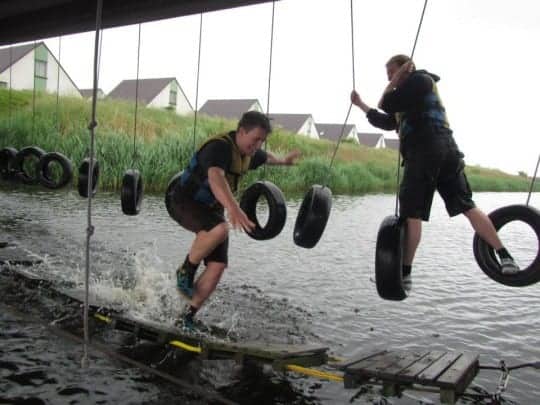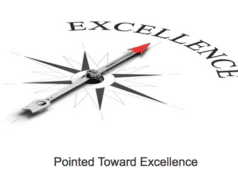Mark's note: Today's guest post is by Gert Linthout, from Belgium. Gert and I were part of the same Lean healthcare study trip to Japan last November. He was the co-creator of this creative video on Kaizen that I featured in this blog post.
 My annual adventure weekend with the colleagues – made up of equal parts party, games, BBQ, campfire and, of course, adventure is now behind us.
My annual adventure weekend with the colleagues – made up of equal parts party, games, BBQ, campfire and, of course, adventure is now behind us.
The ‘push your boundaries' marines obstacle course – a cleverly devised rope bridge across a West Flanders canal augmented with car tires, beams, barrels, etc. – was almost certainly going to lead to many wet participants and wet clothes.
Trust and focus were the key words, according to the instructor, just as they are in day-to-day business. But, business was not what we were concentrating on (or so we thought)… or was the heavy partying of the night before the reason for all our brain cells still being on ‘stand by'?
Braggadocio and doubt
The male colleagues were already crowing that the course wouldn't be a challenge at all. ‘Piece of cake' and ‘no worries' were among the boasts that echoed in the West Flanders wind.
The first hardy soul felt 20 pairs of eye focused on her and went down – literally and figuratively – under the pressure. Her example was soon followed by others. The cries of bravado were weakening in strength with every passing moment and, although conditioning, strength, and perseverance could take one quite far, it was no guarantee of success.
The living bridge was the ultimate challenge: 40 cm narrow, 5 m long, suspended along two loose cords and with no guide ropes. It could be done without much difficulty on hands and knees, but ‘real men do it standing up' according to our coordinator.
Hero #1 lasted all of 10 seconds before landing unceremoniously in the water. To the astonishment of us all, however, our second hero, Tim, managed to make it standing up and dry to the other side. Utmost concentration, keeping the eyes in the distance, and little baby steps, one after another, sealed his victory. It took him three minutes, but he earned the dry clothes that were his prize.
With the skill and grace of a rookie high-wire artist, I chose the standing method and thus aimed for eternal fame. I nearly went in after only half a metre. My confidence began to waver, in sync with my wobbling body. `Don't look at your feet,` I heard someone scream. Good advice, actually. Very good. The trip across the rope went surprisingly quickly. After a minute, I had passed the halfway mark, which was the most difficult. I could smell victory, but fell prey to the sin of pride, resulting in a slip, a slide, and a wet suit.
Men and competition…. I challenged Tim to get to the other side as quickly as possible. He was in the water after only 10 seconds, but refused to give up. He started again and this time, without thinking, filled with risk, almost with his eyes closed. And we had a winner…. he reached the other side in five seconds flat.
Business and marine obstacle courses – they have more in common than you might think
While we were recounting the tales of our daring-do around the evening camp fire, we also saw parallels with what we encounter every day at my company, Möbius:
1. Start with a clear objective. ‘Don't look at your feet'. When you focus clearly on your objective, you have a much smaller chance of falling. You are less inclined to over-correct. Too often, organizations have the tendency to look at their feet, rather than looking ahead and outside and following their objectives.
2. Practice makes perfect. After three tries, we knew how it worked. In a quickly evolving knowledge job, the importance of training cannot be overestimated.
3. Don't be afraid to fall. Tim did it in five seconds rather than three minutes. Why? He wasn't afraid of falling any more… well, he was already wet. Organizations whose employees are given approval (and are even encouraged) to fail create an entrepreneur's mentality and innovate much more quickly and more radically. ‘Fail fast, fail good'.
In the book, The Speed of Trust: The One Thing that Changes Everything, Stephen M.R. Covey describes the trust phenomenon and the impact that it has on everything that you undertake in life and business. It's well worth the read.
Have you learned wise lessons from ‘non-business related' activities? Let me know below by leaving a comment.
Gert Linthout is management consultant at Möbius Business Redesign, a european consulting firm that helps customers at key moments to co-translate strategy to every fiber of the organisation. Gert is a fanatic lean-believer, loves to make small improvements, believes in people and co-creation. He has over 10 years of experience in healthcare, services and industry improvement projects.
Please scroll down (or click) to post a comment. Connect with me on LinkedIn.
Let’s work together to build a culture of continuous improvement and psychological safety. If you're a leader looking to create lasting change—not just projects—I help organizations:
- Engage people at all levels in sustainable improvement
- Shift from fear of mistakes to learning from them
- Apply Lean thinking in practical, people-centered ways
Interested in coaching or a keynote talk? Let’s start a conversation.











[…] Mark’s note: Today’s guest post is by Gert Linthout, from Belgium. Gert and I were part of the same Lean healthcare study trip to Japan back in 2012. He was the co-creator of this creative video on Kaizen that I featured in this blog post. See his previous guest post. […]